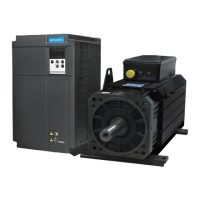IS620P User Manual Chapter 4 Running and Commissioning
- 97 -
Function
Code
Parameter
Name
Setting Range Unit Default
Effective
Time
Property
Control
Mode
H07 20
Reverse speed
limit/Speed
limit 2 in torque
control
0–6000 rpm 3000 Immediate
During
running
T
3. Torque reference limit
The output torque needs to be limited to protect the mechanism. Set the torque limit in H07-07.
Function
Code
Parameter
Name
Setting Range Unit Default
Effective
Time
Property
Control
Mode
H07 07
Torque
limit
source
0: Internal setting
1: External setting
(P-CL and N-CL selection)
2: External T-LMT setting
3: Smaller of external setting
and external T-LMT setting
(P-CL and N-CL selection)
4: Switchover between internal
setting and T-LMT setting
1 0 Immediate At stop PST
Allocate DIs with the P-CL/N-CL function for selecting external forward/reverse torque limit.
Function
No.
Function
Name
Description Setting Remarks
FunIN.16 P-CL
External
forward
torque limit
The torque limit source is switched over
based on the setting of H07-07.
H07-07 = 1:
Valid: External forward torque limit enabled
Invalid: Internal forward torque limit enabled
H07-07 = 3 and AI limit larger than external
forward limit:
Valid: External forward torque limit enabled
Invalid: AI torque limit enabled
H07-07 = 4:
Valid: AI torque limit enabled
Invalid: Internal forward torque limit valid
It is
recommended
that the
logic of the
corresponding
terminal be set
to level valid.
FunIN.17 N-CL
External
reverse
torque limit
The torque limit source is switched over
based on the setting of H07-07.
H07-07 = 1:
Valid: External reverse torque limit enabled
Invalid: Internal reverse torque limit enabled
H07-07 = 3 and AI limit smaller than external
reverse limit:
Valid: External reverse torque limit enabled
Invalid: AI torque limit enabled
H07-07 = 4:
Valid: AI torque limit enabled
Invalid: Internal reverse torque limit valid
It is
recommended
that the
logic of the
corresponding
terminal be set
to level valid.
When the output torque is limited, the DO terminal outputs the C-LT signal described in the
following table.

